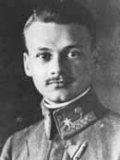Franz Gräser
| Franz Gräser | |
|---|---|
 | |
| Born |
26 October 1892 Nyírmada, Hungary |
| Died |
17 May 1918 (aged 25) Treviso |
| Allegiance | Austro-Hungarian Empire |
| Service/branch | Aviation |
| Rank | Leutnant |
| Unit | Flik 2, Flik 32, Flik 42J, Flik 61J |
| Awards | Order of the Iron Crown, Order of Leopold, Silver Medal for Bravery |
Leutnant Franz Gräser was a World War I flying ace credited with 18 aerial victories.
Gräser was a technical university student in Budapest until World War I broke out. In October 1914, he enlisted in Infanterieregiment No. 72, graduated reserve officer school in mid-July 1915, and began World War I as the commander of a machine gun unit on the Russian Front.[1] After being wounded, he transferred to K.u.K, the Austro-Hungarian air service. He was commissioned as an officer and assigned to observer duties in the rear seat of a reconnaissance aircraft in Flik 2. His skill with machine guns helped him to his first two victories, from the rear seat,[2] on 10 February and 20 May 1917.[3]
Like many observers, Gräser made the transition to becoming a pilot. Unlike just about anyone else, he did so without formal training. The feldwebel pilot who coached him thought he was a natural, but he never received any official training. Without ever being licensed as a pilot, Gräser began flying an Albatros D.III fighter for Flik 42J[4] beginning in September 1917.[5] His personal insignia of an owl on his plane was based in Baltic culture; an owl was considered a sign of death.[6] By the end of 1917, his score stood at 11, with number 11 being claimed on 5 December 1917.[7]
He resumed his victory roll on 26 January 1918 with Flik 61J. By the 23rd of March, he had run his total of wins up to 18 confirmed and one unconfirmed.[8] Most of his victories were over Italian pilots,[9] and his range of victims was wide; seaplanes, fighters, recon two-seaters, and balloons all fell before his guns.[10]
On 17 May 1918,[11] Gräser flew an escort mission, and was shot down in flames by several Italian aces, including Francesco Baracca, Antonio Chiri, Cesare Magistrini, and Gastone Novelli.[12][13]
Sources of information
- ↑ Austro-Hungarian Aces of World War 1. p. 67.
- ↑ http://www.swwisa.net/kuklft/aces.html Retrieved 23 December 2009.
- ↑ http://www.theaerodrome.com/aces/austrhun/graser.php Retrieved on 5 April 2010.
- ↑ http://www.theaerodrome.com/aces/austrhun/graser.php Retrieved on 23 December 2009.
- ↑ Austro-Hungarian Aces of World War 1. p. 68.
- ↑ http://www.swwisa.net/kuklft/aces.html Retrieved 23 December 2009.
- ↑ http://www.theaerodrome.com/aces/austrhun/graser.php Retrieved on 23 December 2009.
- ↑ http://www.theaerodrome.com/aces/austrhun/graser.php Retrieved on 23 December 2009.
- ↑ http://www.swwisa.net/kuklft/aces.html Retrieved 23 December 2009.
- ↑ http://www.theaerodrome.com/aces/austrhun/graser.php Retrieved on 23 December 2009.
- ↑ http://www.theaerodrome.com/aces/austrhun/graser.php Retrieved on 23 December 2009.
- ↑ http://www.swwisa.net/kuklft/aces.html Retrieved 23 December 2009.
- ↑ SPAD XII/XIII aces of World War I. p. 25.
See also
List of World War I flying aces from Hungary
References
- Austro-Hungarian Aces of World War 1 Christopher Chant. Osprey Publishing, 2002. ISBN 1-84176-376-4, ISBN 978-1-84176-376-7.
- SPAD XII/XIII aces of World War I. Jon Guttman. Osprey Publishing, 2002. ISBN 1841763160, 9781841763163.